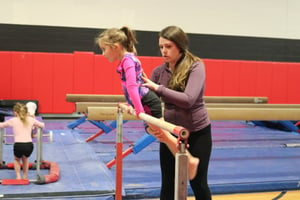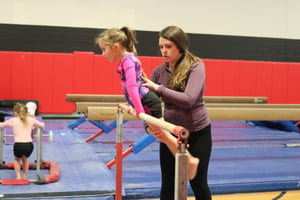Gymnastics is a fantastic sport that combines strength, flexibility, balance, and coordination....
A Beginner’s Guide to Gymnastics Classes Near You
Gymnastics is a fantastic sport that combines strength, flexibility, balance, and coordination. Whether you’re looking to improve your physical fitness, develop new skills, or simply have fun, gymnastics classes can be a great choice for individuals of all ages. This guide will help you understand what to expect from gymnastics classes, how to find the right one near you, and the benefits of participating in this exciting sport.
Understanding Gymnastics
Gymnastics is a sport that involves exercises and performances on various apparatuses. It includes disciplines such as artistic gymnastics, rhythmic gymnastics, and trampoline gymnastics. Each discipline has its unique set of skills and routines, making gymnastics a versatile sport that can cater to different interests and abilities.
Types of Gymnastics
-
Artistic Gymnastics: This is the most recognized form of gymnastics, featuring events like floor exercises, vault, uneven bars, and balance beam. It emphasizes strength, flexibility, and artistic expression.
-
Rhythmic Gymnastics: This discipline combines elements of ballet, dance, and gymnastics, using apparatuses like ribbons, hoops, and balls. It focuses on grace and coordination.
-
Trampoline Gymnastics: This involves performing acrobatics while bouncing on a trampoline. It’s a fun way to develop aerial skills and body awareness.
-
Acrobatic Gymnastics: This form involves partnerships and group performances, showcasing strength and balance through various acrobatic moves.
-
Parkour: While not traditional gymnastics, parkour incorporates gymnastic skills to navigate obstacles in urban environments, emphasizing agility and creativity.
Benefits of Gymnastics
Participating in gymnastics offers numerous benefits, including:
-
Physical Fitness: Gymnastics improves strength, flexibility, and cardiovascular health. It engages multiple muscle groups and promotes overall fitness.
-
Coordination and Balance: The sport enhances motor skills, helping individuals develop better coordination and balance, which are essential for various physical activities.
-
Discipline and Focus: Gymnastics requires concentration and dedication. Practicing regularly instills discipline and helps improve focus, which can translate to other areas of life.
-
Social Skills: Joining a gymnastics class provides opportunities to meet new people and make friends. It fosters teamwork and communication skills.
-
Confidence Building: Mastering new skills and overcoming challenges in gymnastics can significantly boost self-esteem and confidence.
Finding Gymnastics Classes Near You
When searching for gymnastics classes, consider the following steps:
1. Research Local Gyms and Studios
Start by looking for gymnastics gyms or studios in your area. Many facilities offer classes for beginners, so you’re likely to find options that suit your needs. Check their websites for information on class schedules, age groups, and skill levels.
2. Read Reviews and Testimonials
Look for reviews from other parents or participants. Testimonials can provide insight into the quality of instruction and the overall experience at a particular gym.
3. Visit the Facility
If possible, visit the gym to get a feel for the environment. Observe a class in session to see how instructors interact with students and the overall atmosphere of the facility.
4. Inquire About Class Structure
Ask about the class structure, including the instructor-to-student ratio, safety measures, and progression plans. A good program should prioritize safety and provide a clear path for skill development.
5. Consider Trial Classes
Many gyms offer trial classes or introductory sessions. This is a great way to experience the class firsthand before committing to a full session.
What to Expect in a Beginner’s Class
In a beginner’s gymnastics class, you can expect a structured environment where you’ll learn fundamental skills. Here’s a breakdown of what typically happens:
Warm-Up
Classes usually begin with a warm-up to prepare your body for physical activity. This may include stretching, running, and basic exercises to increase heart rate and flexibility.
Skill Development
Instructors will introduce basic skills such as rolls, handstands, and jumps. You’ll learn proper techniques and safety measures to ensure you perform skills correctly.
Apparatus Training
As you progress, you’ll have the opportunity to work on various apparatuses. Beginners often start with the floor and gradually move to other equipment like the balance beam and bars.
Cool Down
Classes typically end with a cool-down period, allowing your body to relax and recover. This may include stretching and breathing exercises.
Safety in Gymnastics
Safety is paramount in gymnastics. Here are some key safety tips to keep in mind:
-
Use Proper Equipment: Always practice on appropriate mats and equipment. Ensure that the gym is well-maintained and safe.
-
Follow Instructions: Listen to your instructor and follow their guidance. They are trained to teach skills safely.
-
Warm Up and Cool Down: Never skip warm-up and cool-down sessions. These are crucial for preventing injuries.
-
Know Your Limits: It’s important to recognize your limits and not push yourself too hard. Progress at your own pace.
Conclusion
Gymnastics is an enriching sport that offers numerous physical and mental benefits. Whether you’re a child or an adult, there are classes available to help you get started. By following the steps outlined in this guide, you can find the right gymnastics class near you and embark on an exciting journey of skill development and personal growth. Embrace the challenge, enjoy the process, and watch as you gain strength, flexibility, and confidence through gymnastics.


